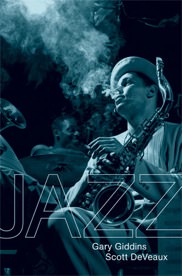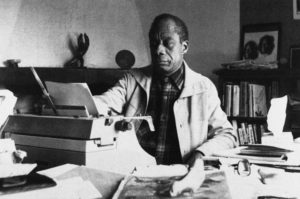A Study of the Worldly Art of Jazz
Developing an appreciation for jazz is partly a matter of understanding how it is influenced by other forces of life, as this review of a new book by Gary Giddins and Scott DeVeaux notes, and how the music plays—and breaks—with form. Developing an appreciation for jazz is partly a matter of understanding how it is influenced by other forces of life.
This review originally appeared in The TLS, whose website is www.the-tls.co.uk, and is reposted with permission.Gary Giddins
and Scott DeVeaux begin their eventually enjoyable Jazz by trying to explain some fundamentals of music theory. Why? This stuff is hard to put succinctly and well. You end up with: “The V chord – G, B, D in C major — [is] known as the dominant. … When you add the fourth degree of the scale to it (producing a seventh chord, G7: G, B, D, F), it sounds as though the entire chord were begging to move, or resolve, to the tonic”. This makes sense to the musician who already knows it. For the average listener, it’s unnecessary. Giddins and DeVeaux themselves seem to have limited understanding of saxophone theory (try playing an alto using clarinet fingerings, with your tongue pressed “lightly against the reed”), which doesn’t prevent them from showing great sensitivity to saxophone timbres not just between players but within a given player’s development.
In their version of harmonic theory they use “Happy Birthday” as an illustrative example, which is fine, and then say that the notes E, A, or B “sound horribly dissonant when played next to an E flat chord”. In fact, the climactic note of “Happy Birthday” — the “Fred” of “Happy Birthday, dear Fred-dy” — is (in the key of B flat) an A against an E flat chord. Children do not recoil in horror. Nor does this misunderstanding prevent Giddins and DeVeaux from offering sophisticated discussions of jazz tunes that use the flat ninth, augmented eleventh, and flat thirteenth — E, A, and B against an E flat chord. “In general”, they say, “minor sounds sad, moody, angry, or even tragic” but that doesn’t stop them noting the “cheerful” quality of the (minor) “My Favourite Things”. And “A Night in Tunisia” (another cheerful minor tune) is not based on the “I Got Rhythm” chord changes. They were probably thinking of “Salt Peanuts”.
Reader, be patient. When Giddins and DeVeaux really like the music, their writing opens and blossoms. By the time they get to Louis Armstrong, the music’s energy seems to energize the text. When they talk about Coleman Hawkins and the invention of swing, the prose, too, swings. Hawkins learnt “how to soften the gruff edges of his timbre and to move from one note to another with a fluid, more gracefully commanding manner [and] with nearly rapturous power”. Ella Fitzgerald “never runs out of steam or breath, carrying the rhythm like an ocean current”. Coltrane’s “was jazz as an existential squawk, a taunting rush of unbridled release”. The flow of the narrative may not quite be rapturous, or unbridled, or strong as an ocean current, but it has enough force to carry us pleasurably along through the decades of jazz’s development.
Although the narrative flows, it is also anchored to the music itself. The book is structured around a series of detailed, though not fussy, analyses of recorded performances. (The book’s accompanying set of CDs is itself an impressive feat. Record companies are usually mean when it comes to licensing their copyrights for such compilations.) And the choice of musical examples is persuasive. The performances work to illustrate stylistic moments as well as being superlative in their own right.
A beauty of jazz as a subject is that it forces the kind of thinking that should be expected of all music history; that is, jazz is so much an art-in-the-world that it’s hard to put aside the influences of politics, race, mass media, popular culture, audiences and money, all of which the authors handle straightforwardly, as in this comment about band leader Louis Jordan: “Jordan reminded people that African Americans had a life, not just a grievance”. They’re forthright about drugs, too, although perhaps they don’t stress enough the ubiquity of hard drugs during the 1950s — the bad part of Charlie Parker’s great influence. But drugs were also a result of the sheer stress of the freelance night life, out of sync with the rest of the world (“I didn’t know there were two ten o’clocks in the day” was one musician’s reaction to being asked to attend a morning photo shoot) and the pressure of being expected to produce inspired improvisations on a nightly basis.They give due weight to life stories, although these tend towards the anodyne. About Charles Mingus’s autobiography Beneath the Underdog, they say “As a memoirist, he brought new insights into the tribulations of African-American artists trying to surmount the constrictions of prejudice”. That’s not how I remember the scene in the Mexican brothel. These were people with nicknames like Bags, Bing, Bix, Bean, Bird, Bubber and Bunk, complicated people who led complicated lives, and loved to tell stories about each other (the authors must know hundreds about Miles Davis alone) often with a sardonic edge (Zoot Sims on Stan Getz: “A great bunch of guys”). I could have done with more like the one about Johnny Hodges, who left the Ellington band for a time “partly out of irritation with Ellington’s habit of appropriating musical ideas — during a tune he felt was actually his own, Hodges would mimic counting out money onstage”. That the careers of Hodges and Ellington were intertwined is obvious to a jazz fan, but for someone fresh to the field, such humanizing anecdotes are essential.
Here is why jazz players love the blues: it is the perfect box to break out of, the most restrictive of musical forms. A composer of Gregorian chant had more freedom than someone trying to write a blues. The number of measures is specified; so are certain chords that must be cycled through; and their temporal position; the tonic chord, defying every rule of harmonic theory, is voiced like the aforementioned dominant seventh, yet still seems final. (How this works remains a mystery.) Performing is another matter. In traditional blues songs there are gaps for improvisation after every line (the singer says “I bought me a coffee grinder, the best one I could find” and the player has two bars in which to improvise a response — one which will probably indicate that she’s not really talking about coffee) and in a jazz performance the song provides the framework for any number of improvised solos. This reveals the secret of jazz performance: First, construct a box. Second, break out of it. In so doing the musician enacts a moment of liberation.
This may be a politically charged term, but surely everyone needs some liberating. It’s obvious Louis Armstrong needed liberation from the mean streets of New Orleans, less obvious that his playing would prove liberating for Philip Larkin in a posh enclave of provincial Coventry. The problem facing Giddins and DeVeaux in their closing chapters is: what happens when jazz has been tamed and civilized and turned into a classical music? What price liberation now, when twenty-first-century jazz seems to be chasing its own tail, “plagued with countless tributes, recreations, and variations on its past”?
The book itself is evidence of a remarkable kind of calm, after all the polemic that once engulfed writing about jazz. The only polemic the authors indulge in is a ritual baiting of so-called smooth jazz — “There are many things to dislike about smooth jazz — for example, everything”. But Kenny G. is everyone’s favourite target. The old passions of swing vs bop, hot vs cool, avant-garde vs everything, seem to have dissipated. Is this peace and consolation, and calm of mind, all passion spent? Or has some of the passion departed the art form along with the polemic? I find it hard to share in the authors’ confidence that “others will continue to forge daring explorations” — the flatness of that phrase makes me doubt how strongly they believe it themselves — but here on the ground, in the bars and the concert halls (I have tickets to hear Eliane Elias on Saturday), great things are still being done.
Stephen Brown’s CD of solo jazz piano music, “Sweet Lorraine,” was released in 2009. He is emeritus professor of music at Southern Illinois University and author of “The Sense of Music,” 1988.
Your support matters…Independent journalism is under threat and overshadowed by heavily funded mainstream media.
You can help level the playing field. Become a member.
Your tax-deductible contribution keeps us digging beneath the headlines to give you thought-provoking, investigative reporting and analysis that unearths what's really happening- without compromise.
Give today to support our courageous, independent journalists.







You need to be a supporter to comment.
There are currently no responses to this article.
Be the first to respond.